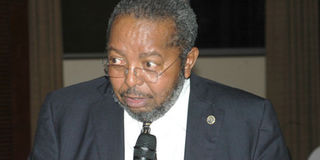Bank of Uganda keeps key lending rate at 17 per cent

Bank of Uganda governor Emmanuel Tumusiime Mutebile. He believes the Ugandan economy has performed well this year. FILE PHOTO
What you need to know:
Bank of Uganda (BoU) yesterday stayed its policy rate, the Central Bank Rate (CBR), at 17 per cent saying it is still effective enough to stabilise inflation pressures as well as support economic growth rate of 5 per cent for this financial year 2015/16
Kampala. Bank of Uganda (BoU) yesterday stayed its policy rate, the Central Bank Rate (CBR), at 17 per cent saying it is still effective enough to stabilise inflation pressures as well as support economic growth rate of 5 per cent for this financial year 2015/16.
Leaving the policy rate unchanged also implies that the lending rate is likely to remain at the same range of 23.7 per cent over the first quarter of 2016.
The decision to keep the rate at 17 per cent has taken some speculators by surprise since they had anticipated a rise due to the increase in the inflation rate.
Stabilising inflation
Presenting the monetary statement, governor BoU Emmanuel Tumusiime Mutebile said due to prevailing macroeconomic forecast, the Central Bank believes this is consistent with stabilising the core inflation and returning it to the target of 5 per cent over the medium term.
Although the projection for the real economic growth for 2015/16 remains at 5 per cent and inflation rate low, however, there are downside risks to the projected growth, including those emanating from the external economic environment, which could deteriorate further over the next 12 months.
Mr Mutebile explained: “The major risks factors may include: slower growth in major emerging market economies; further decline in global commodity prices; as well as the reduced access to external finance for developing countries due to heightened perceptions of risks, and possible monetary policy tightening in the US. Consequently, our balance of payments in the short to medium term will remain vulnerable to external shocks.”
Difficult economic conditions in major emerging market economies such as China, India Brazil and Russia and oil exporting developing countries have seen the International Monetary Fund cutting down the global economic growth from its earlier projection of 3.3 per cent to 3.1 per cent for this year.
Similarly, the World Trade Organisation also lowered global trade forecast from 3 per cent to 2.8 per cent for this year due to falling import demand and lower commodity prices in the global market.
Summing up how Uganda’s economy has faired since January to December 2015, Mr Mutebile said: “The economy has performed very well.”
This is despite the fact that inflation has persistently risen over the last two months, with annual headline inflation rising from 8.8 per cent to 9.1 per cent and the core inflation rising from 6.3 per cent in October to 6.7 per cent in November.
Mr Mutebile said the BoU current inflation forecast over a 12-month horizon is lower than what the Central Bank had communicated in the October monetary policy statement.
“We focus that annual core inflation will peak at around 10 per cent in the third quarter of 2016, and then gradually decline towards 5 per cent target over the medium term,” he said.
However, he cautioned: “As with all forecasts, there are risks associated with this inflation outlook. Future inflation could deviate from the forecast as a result of external shocks and/or shocks to domestic food prices due to the current El-Nino weather conditions.”
Monetary policy
BoU executive director research Adam Mugume said since January to December monetary policy has been effective which has supported domestic credit growth, high economic growth and subdued inflation rate.
“The Shilling denominated loans have been growing at anannual rate of 17 per cent, it is only the foreign currency denominated loans that have registered a decline due to depreciation in the foreign exchange market,” he said.



